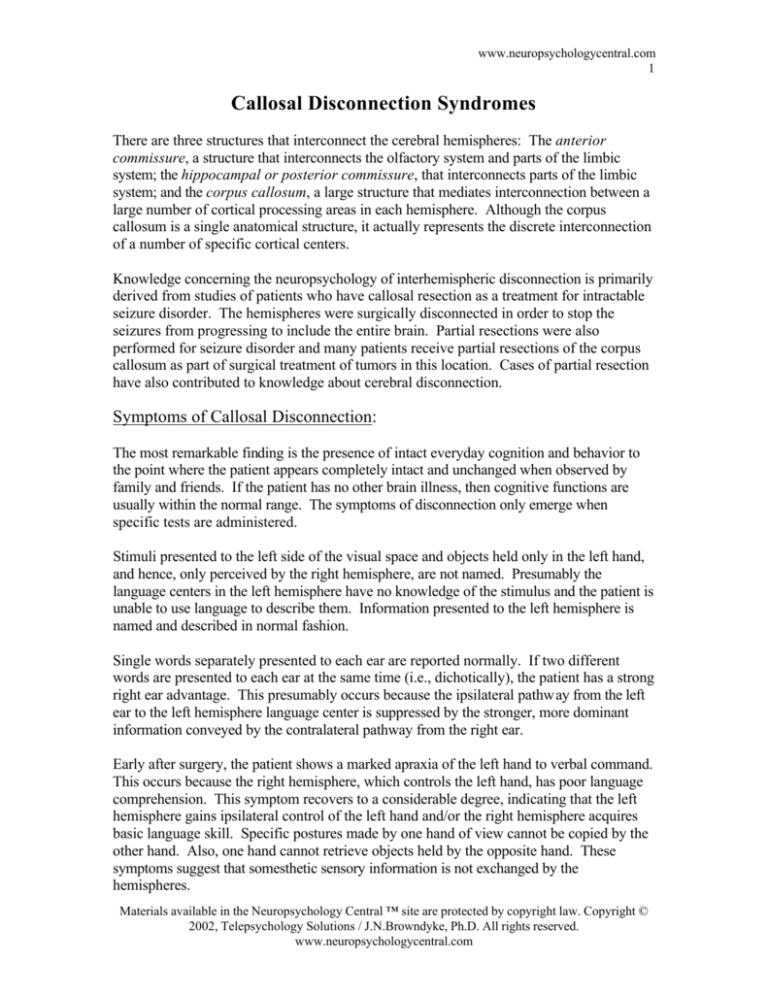
www.neuropsychologycentral.com
1
Callosal Disconnection Syndromes
There are three structures that interconnect the cerebral hemispheres: The anterior
commissure, a structure that interconnects the olfactory system and parts of the limbic
system; the hippocampal or posterior commissure, that interconnects parts of the limbic
system; and the corpus callosum, a large structure that mediates interconnection between a
large number of cortical processing areas in each hemisphere. Although the corpus
callosum is a single anatomical structure, it actually represents the discrete interconnection
of a number of specific cortical centers.
Knowledge concerning the neuropsychology of interhemispheric disconnection is primarily
derived from studies of patients who have callosal resection as a treatment for intractable
seizure disorder. The hemispheres were surgically disconnected in order to stop the
seizures from progressing to include the entire brain. Partial resections were also
performed for seizure disorder and many patients receive partial resections of the corpus
callosum as part of surgical treatment of tumors in this location. Cases of partial resection
have also contributed to knowledge about cerebral disconnection.
Symptoms of Callosal Disconnection:
The most remarkable finding is the presence of intact everyday cognition and behavior to
the point where the patient appears completely intact and unchanged when observed by
family and friends. If the patient has no other brain illness, then cognitive functions are
usually within the normal range. The symptoms of disconnection only emerge when
specific tests are administered.
Stimuli presented to the left side of the visual space and objects held only in the left hand,
and hence, only perceived by the right hemisphere, are not named. Presumably the
language centers in the left hemisphere have no knowledge of the stimulus and the patient is
unable to use language to describe them. Information presented to the left hemisphere is
named and described in normal fashion.
Single words separately presented to each ear are reported normally. If two different
words are presented to each ear at the same time (i.e., dichotically), the patient has a strong
right ear advantage. This presumably occurs because the ipsilateral pathway from the left
ear to the left hemisphere language center is suppressed by the stronger, more dominant
information conveyed by the contralateral pathway from the right ear.
Early after surgery, the patient shows a marked apraxia of the left hand to verbal command.
This occurs because the right hemisphere, which controls the left hand, has poor language
comprehension. This symptom recovers to a considerable degree, indicating that the left
hemisphere gains ipsilateral control of the left hand and/or the right hemisphere acquires
basic language skill. Specific postures made by one hand of view cannot be copied by the
other hand. Also, one hand cannot retrieve objects held by the opposite hand. These
symptoms suggest that somesthetic sensory information is not exchanged by the
hemispheres.
Materials available in the Neuropsychology Central ™ site are protected by copyright law. Copyright ©
2002, Telepsychology Solutions / J.N.Browndyke, Ph.D. All rights reserved.
www.neuropsychologycentral.com
www.neuropsychologycentral.com
2
Studies of callosal disconnection have revealed that the right hemisphere has a significant
lexicon of single words. Consequently, the left hand is able to name some objects or find
objects by touch when given the name.
•
Intermanual Conflict and the “Alien Hand”
With callosal disconnection, the actions of each side of the body are independently
controlled by the contralateral hemisphere. Since there is no communication across the
hemispheres that can mediate coordinated action, the patient’s hands often act is if they
were independently motivated. This is most apparent when the left hand behaves
inconsistent with what the patient says he is doing. Sometimes patients will notice the
aberrant actions of the left hand and comment on the behavior as if the hand did not belong
to them. This presumably represents the language center in the left hemisphere commenting
on the dissociated actions of the left hand. One example often cited is that of a patient who
was buttoning his shirt with one hand while the other hand followed behind unbuttoning it.
Another patient was in the habit of slapping the left hand when it would behave errantly.
Patients report that the hand is out of their control and hence “alien”.
•
Verbal Anosmia
Patients with callosal disconnection are unable to name smells presented only to the
right nostril. Smell sensation in the right nostril is intact since the patient can use the left
hand to find an object corresponding to the smell.
•
Double Hemianopsia
Patients with callosal disconnection cannot indicate the onset of a visual stimulus in the
left or right visual field with the contralateral hand. For example, when a visual stimulus
appears in the right field, the patient can indicate the onset of the stimulus with the right
hand but not with the left hand. This is because visual information from the right field is
perceived by the left hemisphere. Since this hemisphere controls the right hand, the patient
can respond. Since the corpus callosum is severed, visual information from the right visual
field is never perceived by the right hemisphere. This hemisphere controls the left hand
and it cannot respond to the stimulus. The opposite pattern holds for the response of the
right and left hands to stimuli presented to the left visual field.
•
Processing of Verbal Information
Patients with callosal disconnection will have a complete right ear advantage for verbal
information. Verbal information is very poorly perceived by the left ear. Dichotic
presentations of verbal content result in an almost complete preference for the verbal
stimuli presented in the right ear.
•
Unilateral Apraxia of the Left Hand
Here the patient cannot perform an action with the left hand to verbal command that is
easily performed by the right hand. The patient may be able to perform the action
spontaneously (i.e., when not specifically to verbal command) or when given an object to
hold that is used in the action.
Materials available in the Neuropsychology Central ™ site are protected by copyright law. Copyright ©
2002, Telepsychology Solutions / J.N.Browndyke, Ph.D. All rights reserved.
www.neuropsychologycentral.com
www.neuropsychologycentral.com
3
•
Unilateral Agraphia of the Left Hand
Patients with callosal disconnection have an inability to write with the left hand; the
right hand writes fluently. In addition, the left hand is able to carry out other coordinated
movements. It is apparent that the language centers controlling writing in the left
hemisphere can no longer coordinate the left hand to produce language-related productions.
•
Unilateral Anomia
Patients cannot name objects placed in the left hand when blindfolded. They can easily
name objects placed in the right hand. Tactile information about an object placed in the
left hand never reaches the language centers in the left hemisphere and the object cannot be
named.
•
Unilateral Constructional Apraxia
Callosal Disconnection results in poor performance by the right hand on tasks that
require spatial processing. These include copying geometric forms and construction tasks.
Spatial processing centers in the right hemisphere do not have access to the right hand and
cannot guide its actions. This disability also extends to solving arithmetic problems on
paper. If the problem requires the proper lay out of the numbers on paper then the patient
may have difficulty solving it.
Assessment:
The evaluation of cerebral disconnection utilizes a number of specific, experimental
procedures described above. It is very difficult for the typical clinical neuropsychology
laboratory to adequately assess this syndrome because the necessary equipment is not
available. For example, very few centers have tachistoscopes (i.e., specialized equipment
used to present visual stimuli separately to each half of the visual fields).
Some of the assessment procedures involving the disconnection of actions of the hands in
response to sensory stimulation are tested with simple procedures. For example, unilateral
apraxia can be examined by requesting the patient to perform some simple act with the left
hand while the eyes are closed. The examiner may also position the right hand in some
way and ask the subject to reproduce the position with the left hand while the eyes are
closed. In a similar fashion, the examiner may test unilateral anomia and unilateral
construction apraxia.
Materials available in the Neuropsychology Central ™ site are protected by copyright law. Copyright ©
2002, Telepsychology Solutions / J.N.Browndyke, Ph.D. All rights reserved.
www.neuropsychologycentral.com









